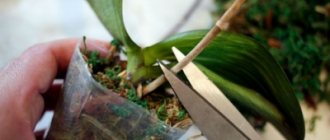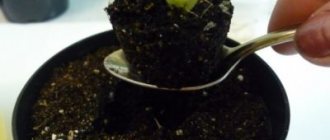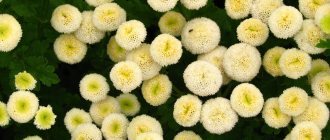What kind of plant is this?
Phalaenopsis rosea is a genus of epiphytic plants belonging to the Orchid family. The herbaceous plant lives in northeastern Australia, the Philippines and Southeast Asia.
A special feature of this species are the round flowers of a soft pink color.
The orchid grows on trees, but does not parasitize due to their nutrients . Loves well-ventilated soil, can grow on stones, rock crevices, usually near water bodies.
Hybrids
There are many hybrids among orchids. These are varieties that were bred through selective breeding. They do not grow in the natural environment, but they are better adapted to life in indoor conditions than others. That is, this culture does not react so quickly to changes in external factors, making it more suitable for novice gardeners.
The Dragon
This is one of the most popular hybrids today. Here is a brief description of it:
- The height of the peduncle can reach 60 cm.
- The stem is thin, dark in color, completely hidden by leaves.
- The leaves are hard and bright green. There can be up to six of them.
- The flowers have a typical orchid shape. Delicate, pink. There are a large number of dark dots on the petals.
- The lip is yellow-white. There are also dark spots on it.
This plant has extraordinary beauty and is also very easy to care for. That is why many gardeners today prefer to grow this particular variety of orchids at home.
With white spots (Panther)
This is another classic orchid hybrid that was obtained through selection. It is not found in the natural environment.
Externally, the flower is similar to the Dragon orchid, but there are differences:
- five petals white;
- there are a large number of pink spots of different shapes and sizes on the petals;
- the lip is completely pink, separated from the main flower by about two centimeters.
The panther is an incredibly beautiful flower, which at the same time requires standard care. The height of the peduncle can reach 60 cm.
Royal terry
This orchid is a little different from all the others. Here are its features:
- The size of the plant reaches one meter.
- The flower is regular in shape, completely pink. There are no inclusions on it. The buds are large and emit a pleasant aroma.
- The flowers are light and beautiful, pink in color.
Botanical characteristics
Phalaenopsis look like herbaceous bushes with fleshy leaves at the base.
The green bush develops into a powerful root system covered with a layer of wax. Due to the high chlorophyll content, when saturated with moisture, it turns green. Pink orchids, as a species, are small in size. It has leathery, dense leaves arranged in rosettes. They have an oval-oblong shape and a dark green color, although sometimes they are found with a reddish tint. The length of the sheet can reach 15 cm, and the width – 8 cm. As a rule, in the spring and autumn seasons, 1-4 flower stalks appear from the leaf axils.
The peduncle is curved and has a dark purple color. Its length ranges from 25 to 30 cm. Up to 15 light pink flowers , united in rosettes, can grow on one peduncle. They germinate one by one and reach 3 cm in diameter.
Color
Phalaenopsis is naturally white or white-pink in color, sometimes with a slight hint of salmon color. Thanks to breeders who have since ancient times crossed different types of orchids, orchids of other shades have appeared - yellow, blue and others.
Previously , plants with tall peduncles and large white flowers were considered the most valuable . Thus, the image of Phalaenopsis arose, equated to the standard. It is a plant with medium-sized flowers of porcelain white, soft pink or light purple.
Later, breeders developed varieties with flowers whose diameter could reach 15 cm. The natural grace of the orchid was completely lost in hybrid plants of this variety.
Phalaenopsis pink, Aphrodite, Stuart and Schiller (with photo)
Pink phalaenopsis – Phalaenopsis equestris (Ph. rosea). Its homeland is the Philippines, where it is the most common species of the genus; grows in valleys along river banks. One of the miniature species of the genus. The leaves are oval or oblong, 10–15 cm long, 7–8 cm wide, dark green, sometimes reddish below. The gracefully curved dark purple, relatively short (20–30 cm) peduncle bears 10–15 small white-pink flowers about 3 cm across, blooming sequentially one after the other. The sepals are oblong, white, with a soft pink indistinct longitudinal stripe, the petals are wider than the sepals, of the same color, but with an intense pink stripe.
Look at the photo - the lip of a pink phalaenopsis is small, three-lobed: the side lobes are directed forward, pink at the base, white on the inside, with 3-5 dark purple short lines:
The middle lobe is diamond-shaped or ovoid, bright pink, with a brownish tint at the base, sometimes with a white tip. Anther with a long beak.
Phalaenopsis Aphrodite - Phalaenopsis aphrodite. White, sometimes with a pink blush, flowers similar to Phal. amabilis, but smaller in size and collected in cascading clusters. The lip is colored pink and yellow and has two thin, curled antennae.
Pay attention to the photo - Phalaenopis Aphrodite has brownish-green leaves, with veins in the center, about 30 cm in length:
Stuart's Phalaenopsis - Phalaenopsis stuartiana. This charming species has small, creatively colored flowers. Young leaves are variegated, mature leaves are grayish-green, purple underneath. Sepals are white, with pale yellow sides on the inner half and red spots at the base. Petals are white, with light purple spots at the base. The golden-yellow lip has a white pattern with purple spots and a pair of horns at the top.
As you can see in the photo, Phalaenopsis Stewart's flowers are collected in branching racemes and are well preserved:
Schiller's Phalaenopsis - Phalaenopsis schilleriana. This remarkable species produces stunning drooping racemes, branching and bearing as many as a hundred mauve flowers. The plants have long leaves streaked with greyish-white stripes and purple underneath. The roots are flat and tough. The flowers are about three inches across.
The photo shows that in Schiller’s phalaenopis the pink tone of the petals and sepals fades at the edges:
The lip is the same color, with red dots. Instead of antennae, there is a pair of diverging horns at its top. Grows in the Philippines, blooms in spring. This species is widely used in hybridization to combine its branched, dense arrangement of flowers on the peduncle with the denser substance and large size of white hybrids.
Types: description and photo
Pink orchids of this variety can be divided into 4 categories, two of which are classified as varieties, and the others as hybrids:
- Schiller.
- Stewart.
- Mini and midi.
- Hybrids.
Schiller
This is the most common variety of orchids of this species, and is native to the Philippines. The plants have a silvery coating on their leaves, which is dotted with dark green spots united into stripes. Most hybrids have been created based on Schiller's orchids .
Phalaenopsis Schiller in hybrid varieties produces a huge number of flowers. A record was recorded - 174 flowers on one peduncle.
Stewart
Almost identical to the Schiller orchid. It differs only in its branching peduncle and small flowers. They have a specific pattern - a transitional tone of pink.
The Stewart's orchid is native to the Philippines, particularly the island of Mandanao.
Mini and midi
Mini and midi orchids are notable for their compact size . The height of midi orchids can reach 40-55 cm, and the length of the leaf is 20 cm with a peduncle thickness of 0.7 cm. Not all of them are pink in color, but some individuals still have a delicate shade.
Hybrids
Orchid varieties with exotic colors:
- Pink Dragon.
- Pink Panther.
- Single pink.
- Pink cherry.
- Grandiflora pink.
- Pink dreams.
- Royal double pink phalaenopsis.
Phalaenopsis can become a decoration for your home; for these purposes, we suggest choosing varieties for growing such as Liodoro, Big Lip, Multiflora, Wild Cat or Mix.
Diseases and pests
Periodically, the orchid is attacked by various pests:
It's quite difficult to fight them. If a thin mite leaves the plant when air humidity rises, then other pests need to be fought by destroying their eggs. For this, special poisons are used . However, they must be used in small quantities so as not to harm the culture itself.
As a result, the effectiveness of control is reduced, but the flower is preserved. To get the desired result, it is necessary to carry out not 2-4 sprayings, but about eight due to the reduced dosage of the chemical.
Thus, pink orchid varieties require standard care. It is recommended to buy soil in special stores to avoid problems with pests. With proper care, they will not appear, and the flower itself will feel great.
If the leaves begin to turn yellow, it is necessary to adjust the intensity of watering. If there is root rot, it is necessary to dry them and replant the plant. The flower will thank you for your care with long and intense flowering, which can last for several months.
History of appearance
It is officially recognized that the first pink Phalaenopsis orchid was found on the Moluccas by the naturalist Rumph , who sent it to a scientist friend in Britain. The flower arrived already dry, but the British botanist put it in water. A week later, the UK's first tropical pink orchid bloomed.
In 1752, a flower of extraordinary beauty was found by the Swedish pastor Osbeck in Eastern Indonesia on the island of Ternate. The man sent it to the famous naturalist physician Carl Linnaeus for study.
The scientist described the plant in the scientific work “Classification of the Flora and Animal World.” In it, Phalaenopsis received the name “Epidendrum admirable,” that is, “living in trees.”
Selection
The first hybrid pink orchid was created in 1875 by John Seden , the appearance of flower stalks was noted in 1886. During this time, 13 more primary hybrids were bred.
In 1920, the first large-flowered Phalaenopsis was created in France. And after 7 years there was a second one, with a large size and a rigidly defined flower shape. In 1940, the large-flowered orchid grex was created. It differed from its analogue in the large number of flowers on the peduncle and flat, dense, pure white flowers.
It was not until the 1950s that high-quality rose flowers were produced . The basis was an orchid with petals that have a pinkish tint on some parts and a large-flowered hybrid. After 10 years, the direction of the breeders changed - a wave of creating miniature Grexes began.
Reproduction methods
Indoor orchids reproduce vegetatively, but you should know the type of plant. For example, sympodial species have more than one growth point on the shoot. It develops, forms a rosette and pseudobulb.
A monopodial orchid has one growth point; rosettes are formed from points that are located on the peduncle.
Plants are propagated by dividing the bush in the spring. The flower is taken out of the pot, the roots are divided into parts so that the new plant has its own root system. This requires the presence of 2-3 pseudobulbs. The sections are sprinkled with activated or charcoal.
It is important to know! When propagating orchids at home, do not make the mistake of leaving young pseudobulbs on the mother orchid. Thanks to this, the plant grows quickly and fully blooms (has a strong inflorescence). Orchids are propagated by cuttings, this option is suitable for monopodial plants
These types of work are carried out in the spring. The top with several roots is cut off from an adult orchid. The sections are treated with charcoal and fungicide. The cut-off upper part is placed in a greenhouse above water to grow roots, and the lower part with the rhizome continues with normal care in the hope of getting a baby.
Orchids are propagated by cuttings; this option is suitable for monopodial plants. These types of work are carried out in the spring. The top with several roots is cut off from an adult orchid. The sections are treated with charcoal and fungicide. The cut-off upper part is placed in a greenhouse over water to grow roots, and the lower part with the rhizome is continued with normal care in the hope of getting a baby.
There are orchids that reproduce by peduncle. After waiting for the flower to rest, cut off the arrows and divide them into parts, each of which should have a dormant bud. Next, the cuttings are sprayed with a fungicide and placed in moistened moss, but the bud should be on the surface.
Maintaining room temperature, the cuttings are kept under film until an independent plant with its own roots is formed. Carry out regular treatment to avoid the formation of rot and mold.
Orchid propagation by cuttings.
Cuttings can be rooted in water, but humidity and temperature should be maintained; to do this, cover the planting material with a bag. To better awaken the kidney, you can apply cytokinin paste to it and around it.
Reproduction is possible by daughter rosettes (children), for this the following conditions are created:
- high humidity;
- the substrate must be enriched with nitrogen;
- the temperature should be warm enough.
Propagation by seeds is a very labor-intensive method; the implementation of this method is possible only in specially created laboratory conditions. Enthusiasts practice this method at home; you can read about their successes on forums and YouTube.
Care
The orchid is a capricious plant that requires strictly defined conditions for its maintenance:
- Temperature regime . The plant requires a minimum of 20oC in winter and up to 35 in summer. Temperatures dropping to 100 at night can kill a pink orchid.
- Location . Pink Phalaenopsis does well on windows facing east or west.
- Light .
In winter, the plant requires additional lighting using fluorescent lamps. The pink orchid requires 12 hours of daylight for normal growth. - Watering . Pink orchids require moderate watering. In summer, they are moistened as they dry - two to three times a week; in winter, the volume is reduced to several times a month. The water should be settled and at room temperature.
Top dressing
The pink orchid must be fertilized with a complex product for orchids. It is added to the moistened substrate so as not to burn the root system. Too much fertilizer can lead to cracks in the leaves and lack of flowering. When choosing a fertilizer for a flower, you need to choose one with the lowest nitrogen content.
Transfer
Moss, pine bark, and charcoal are used as soil for pink Phalaenopsis . Plants are planted in transparent plastic pots to control the position of the roots, monitor the need for moisture, and prevent the plant from dying off.
Transplantation is carried out only when absolutely necessary, once every few years. The procedure is performed only after flowering. The bottom of the pot is covered with drainage. Dried roots are cut off and the old soil is cleaned out. The orchid is placed in a new pot and carefully covered with substrate, without pressing it to the roots.
We invite you to watch a visual video about orchid transplantation:
Reproduction
Daughter plants can be separated during transplantation. Orchids can also be propagated by children that sprout on the flower. Young inflorescences will appear after about a year .
Pests and diseases
- The most common problem with pink Phalaenopsis is root rot. The flower can be saved by timely pruning of the affected areas, replacing the soil and reducing the amount of watering during the recovery period.
- The orchid is susceptible to attacks from aphids and red mites, which spread from a diseased plant to a healthy one.
When purchasing a flower, you need to carefully examine the leaves and flowers; you can notice lesions on them from mealyworms when infected with parasites.
The pink orchid is a rather capricious plant to care for . However, if you follow all the above recommendations, a flower “like a moth” can bloom on your home windowsill, which has delighted the eyes of scientific botanists and ordinary people for hundreds of years.
Features of caring for pink orchids
If you decide to grow pink orchids on your windowsill, you need to remember a few simple rules that will help the plant take root and delight its owners with beautiful flowering:
- the optimal air temperature is 20 degrees in winter and no more than 35 in summer;
- It is better to install the pot on windows that face west or east;
- on hot days the flower requires shading;
- in winter the plant needs additional light;
- For irrigation you need to use settled water at room temperature.
Pink orchids will decorate any home, bringing coziness to it. But in order for a flower to please its owners for many years, you need to sincerely love it and care for it.











